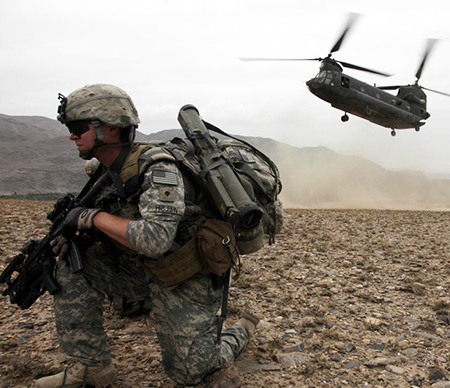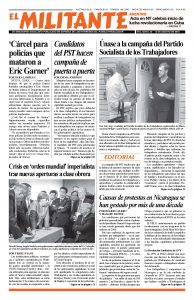As the Democrats and Republicans — the twin parties of capitalist rule — gear up for the 2018 elections, both continue to be wracked by political crises that have accelerated following the election of Donald Trump as president. What lies beneath these conflicts is their inability to prevent working people from looking for ways to stand up to the assaults that flow from the capitalist rulers’ economic, social and moral crisis.
The liberal media pundits, Democrats of all stripes and some Republicans, are lathered up in a furious “resistance” to the Trump presidency, and try to counter his every move with renewed efforts to bring him down. The real aim of their wrath is the working class, who they increasingly fear.
In the introduction to The Clintons’ Anti-Working-Class Record; Why Washington Fears Working People, Socialist Workers Party leader Steve Clark explains that these meritocratic liberals “recognize that more and more working people are beginning to see that the bosses and their political parties have no ‘solutions’ that don’t further load the costs — monetary and human — of the crisis of their system on us.”
This “anti-Trumper” bloc has been taking aim at his administration’s foreign policy. Following Trump’s July meeting with Russian President Vladimir Putin, former CIA Director John Brennan claimed the president’s conduct was “nothing short of treasonous.”
Washington seeks to lessen tensions
The foreign policy of the White House takes place amid the coming apart of almost all the institutions the U.S. rulers put in place in the late 1940s, out of their victory in the second imperialist World War, to defend their “world order.” From sharpening disputes within NATO to growing conflicts among the capitalist rulers in the EU, this world order is shattering.

This process has been accelerated by Washington’s course since the implosion of the Soviet Union in 1991. The U.S. rulers thought — incorrectly — that this meant they had “won” the Cold War, and could move on Russia’s borders and make war wherever they thought it would advance their interests with impunity. The result has been growing tensions with Moscow and decades of wars Washington can’t ever seem to win in the Middle East, Afghanistan and elsewhere.
Faced with this world, and the start of Washington’s decline in relation to Beijing, Trump is trying to strengthen the U.S. government’s military machine to maintain its dominance. At the same time, he is moving to pull back from relying on bloody wars to impose Washington’s will around the world, as previous administrations did with devastating consequences for workers.
The Trump White House seeks to advance the U.S. rulers’ interests through pressure, then moves for talks with Moscow, the North Korean government and the Taliban in Afghanistan, in an effort to reduce conflicts and win some stability for U.S. interests. He is pressing for negotiations between the Israeli rulers and Palestinian leaders. For working people in the Mideast and elsewhere — and for workers in the U.S. who are used as cannon fodder in Washington’s wars — these political developments are followed with great interest.
In fact, much of what Trump is doing along these lines — with the motivation of stabilizing the interests of the U.S. capitalist rulers, of which he is one — unintentionally opens more room for workers to talk, discuss and act in their own class interests.
For liberals determined to put a minus wherever Trump puts a plus, they’re driven to see more wars in the cards. Former U.S. Ambassador to the Democratic Republic of the Congo Dan Simpson, a long-standing critic of Trump, elaborates on this.
Writing in the July 25 Pittsburgh Post-Gazette, Simpson says, “The rising tide of the Mueller investigation, personal scandals and the general wreckage of U.S. foreign policy” wrought by Trump are leading him to start a war with Iran, which will break out pretty soon. “Trump could use a war right now, in hopes of rallying Americans around the flag — and him.”
But on July 30 Trump announced he was ready to meet with Iranian President Hassan Rouhani without any preconditions. The administration’s course towards Tehran — bring pressure to get talks and a “better deal” for Washington — isn’t aimed at starting a war.
The fact is, many workers sense that wars are less likely under this administration than its predecessors. This, along with the upturn in the capitalist business cycle and its impact on jobs, means Trump is likely to be re-elected, bar some sharp shift in the objective situation.
Rulers’ political crisis deepens
The Republican Party is deeply divided. Trump has his own politics and team. His administration has little to do with traditional party shibboleths — like small government. From former Tea Party stalwarts to the Wall Street Journal editorial board, Trump isn’t their guy. They aren’t sure what to do to retain their party’s future.
The so-called “progressive” Clinton wing of the Democrats are depressed about 2018 because the seats in play are “not dominated by well-educated, suburban districts that voted for Hillary Clinton,” Nate Cohn wrote in the New York Times July 30. They are instead, he bemoans, “working-class and rural districts that voted for Donald J. Trump.”
For liberals like Cohn the outcome of Clinton’s 2016 defeat at the hands of “uneducated” workers was a disaster they can’t accept. The Bernie Sanders wing of the splintered Democrats has used the primary win by Democratic Socialists of America member Alexandria Ocasio-Cortez in New York’s 14th Congressional District to advance their reform program and seek to take over the party. Of course, she didn’t actually win by turning out the masses. Over 80 percent of eligible voters stayed home.
Ocasio-Cortez — like Sanders, who she used to work for — focuses on attempts to make capitalism “nicer” and “fairer,” obscuring the reality that what workers face is the product of the irreconcilable interests of the class that holds power — the propertied owners. More than anything else, her aim is to staunch the desertion of workers increasingly disillusioned with the capitalist parties and get them back into the Democratic Party.
When members of the Socialist Workers Party campaign door to door in working-class neighborhoods, they find widespread discussion and debate about the roots of the rulers’ crises and wars, and interest in a party that advances a working-class road forward.

